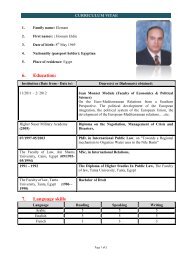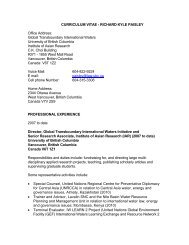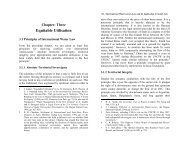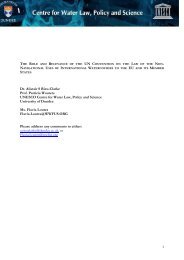Upreti, Trilochan, International Watercourses Law and Its Application ...
Upreti, Trilochan, International Watercourses Law and Its Application ...
Upreti, Trilochan, International Watercourses Law and Its Application ...
Create successful ePaper yourself
Turn your PDF publications into a flip-book with our unique Google optimized e-Paper software.
182 / <strong>International</strong> <strong>Watercourses</strong> <strong>Law</strong> <strong>and</strong> <strong>Its</strong> <strong>Application</strong> in South Asia Prospects <strong>and</strong> Problems of Nepalese Water Resources / 183immediately becomes surface runoff; out of the remaining 36%,some is retained in the form of snow <strong>and</strong> ice in the highHimalayas, while some percolates through the ground as snow<strong>and</strong> groundwater, <strong>and</strong> some is lost by evaporation <strong>and</strong>transpiration. The water retained in the form of snow feeds therivers during the dry season. 7The available hydrological data reveals the estimated annualrunoff into the rivers of Nepal to be 220 billion cubic metres,with the average annual precipitation being 1530 mm per year. 8The influence of heavy rain during the monsoon causes widefluctuations in river flow, l<strong>and</strong> erosion <strong>and</strong> l<strong>and</strong>slides, which isaggravated by the extreme topographic relief <strong>and</strong> fragilegeological construction of the country. These factors cause therivers to carry high sediment loads during high flows.Moreover, the snow <strong>and</strong> glacier melt also brings heavy loads ofsediment during summer months, which is considered animportant factor determining the extent of water-related hazardsin the downstream territory. 9Nepal possesses energy in the form of hydropower <strong>and</strong>firewood; no other energy resources have been discovered insignificant quantities (e.g. coal, oil, gas). Hydropower offershuge potential, but so far only 20% of the population haveaccess to electricity. Several studies suggest that Nepaltheoretically has 83000 MW of hydropower potential, morethan the combined total produced by the United States, Canada<strong>and</strong> Mexico, of which about 43000 MW is presently consideredeconomically viable to harness. 10 Despite the abundance ofwater resources, only about one third of the population has got7 Ibid.8 C.K. Sharma, A Treatise on Water Resources of Nepal, Kathm<strong>and</strong>u:Sangita Sharma, 1999, p. 33.9 C. P. Sinha, "Sediment Management; A Co-operative Indo-NepalVentures" (1994) in 4 Water Nepal, pp. 158-163.10 S. P. Subedi, “Hydro-Diplomacy in South Asia: The Conclusion of theMahakali <strong>and</strong> Ganges River Treaties” (1999) in 93 AJIL, p. 954.access to safe water, <strong>and</strong> only 42% of the net calculated l<strong>and</strong>has been irrigated so far. 11This chapter aims to discuss <strong>and</strong> analyse the abundance of thewater resources in Nepal, their significance for the country’ssocio-economic development, <strong>and</strong> associated legal issues fromthe perspective of IWL. Furthermore, issues inextricablyintertwined with the transboundary freshwater resources,(ranging across hydrological, geographical, political, socioeconomic,<strong>and</strong> technical fields) will also be dealt with in thelight of existing legal principles <strong>and</strong> practices. The issues ofbilateral Indo-Nepal co-operation <strong>and</strong> of regional cooperationwith Bangladesh <strong>and</strong> Bhutan will also be covered, with a focuson water resource issues. These issues will be criticallyanalysed in the light of the previous chapter’s discussion ofequity4.2 Potential for Nepalese <strong>Watercourses</strong>Nepal is endowed with immense water resource’s potential,which, if utilised properly would be a boon both for herself <strong>and</strong>for countries further downstream. The benefits could be appliedto several spheres, namely hydropower generation, theextension of irrigation facilities, <strong>and</strong> particularly navigation,which is crucial for the l<strong>and</strong>locked countries of Nepal <strong>and</strong>Bhutan <strong>and</strong> the north-eastern states of India, which couldaccess the sea via Bangladeshi territory. Moreover, floodcontrol, industrial, recreational <strong>and</strong> other benefits arepossible. 12 However, the reality is that in order to gainmaximum benefits, such transboundary resources should bedeveloped in a holistic <strong>and</strong> integrated manner ignoring nationalbarriers. This is because, due to the nature of these rivers <strong>and</strong> ofthe geography of the area, the optimum site for the barrage (a11 Supra note 2. pp. 13-14.12 B. Crow, A. Lindquist & D. Wilson, Sharing the Ganges: The Politics<strong>and</strong> Technology of River Development, New Delhi: Saga Pub., 1995,pp. 218-237.












